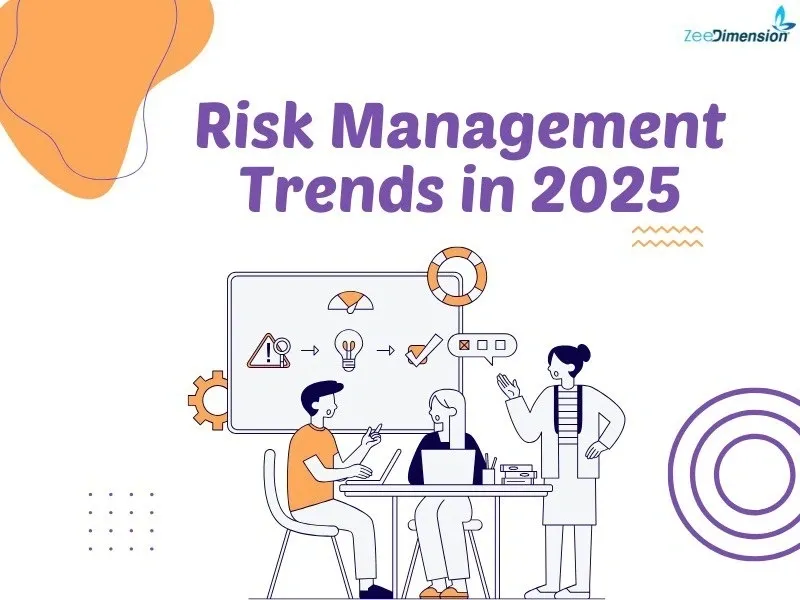
As we move into 2025, risk management is evolving rapidly due to technological advancements, environmental challenges, and global interconnectedness. Companies are adopting innovative strategies, using AI for proactive risk insights, and rethinking approaches to stay ahead in climate risk. Key trends shaping the future include AI-driven risk identification, focus on ESG, prioritizing cybersecurity, and enhancing operational resilience and adaptability. RegTech is streamlining compliance, while human-centric strategies are promoting workforce well-being. Blockchain is improving transparency and reducing fraud, real-time dashboards are aiding decision-making, and cross-industry collaboration is addressing shared challenges.
1. AI-Driven Risk Insights
Organizations are increasingly using AI to improve their risk management methods. Companies can use AI to detect future dangers, making them more proactive and prepared. AI also automates risk evaluations, streamlining and increasing efficiency. AI provides actionable insights, enabling decision-makers to make data-driven choices, manage potential dangers effectively, and capitalize on opportunities efficiently.
2. ESG Risks Take Center Stage
ESG issues have become a top priority for businesses as they adjust to changing expectations and requirements. Organizations are incorporating climate risk into their strategy to ensure long-term viability and resilience. To foster trust and responsibility, organizations are increasing openness in ESG reporting, providing clear insights into their practices and impact. Supply chain sustainability is a growing concern, with firms ensuring operations and partnerships adhere to environmental and ethical standards responsibly.
3. Cybersecurity: A Top Priority
In 2025, cybersecurity remains a primary focus for enterprises, with numerous key themes influencing their strategy. Zero Trust Architecture is becoming common, ensuring consistent, rigorous security procedures are applied across all network access points effectively. Companies are also focused on comprehensive ransomware response plans to rapidly and efficiently neutralize any attacks and limit damage. Third-party risks are scrutinized closely as firms recognize the need to identify and manage supply chain vulnerabilities to prevent security breaches.
4. Operational Resilience Gains Focus
Organizations are increasing their resilience by applying measures to improve their ability to endure disturbances. Building redundancy into important systems ensures continuation in the case of a failure. Companies are developing dynamic business continuity strategies to adapt to changing circumstances and maintain efficient operations during emergencies. They stress-test crisis scenarios to identify flaws and improve preparedness, enabling companies to respond more effectively when real-world obstacles arise.
5. RegTech Revolution
Regulatory Technology (RegTech) streamlines compliance processes for firms by using modern tools to simplify and improve efficiency. Automated regulatory monitoring guarantees that businesses comply with the most recent legal standards without the need for manual intervention. Real-time compliance reporting provides rapid insights into an organization’s conformity to regulations, allowing for swift adjustments as needed.RegTech helps organizations adapt to complex regulations like GDPR and CCPA, simplifying data privacy management and reducing non-compliance risks.
6. Human-Centric Risk Strategies
Companies are increasingly emphasizing their staff by implementing measures that promote employee well-being and create a safe working environment. They are encouraging mental health programs to create a friendly and healthy working atmosphere. Policies are being revised to handle the inherent risks associated with hybrid work arrangements, ensuring that employees are well-prepared to negotiate this flexible environment efficiently. Companies are also investing in training programs to increase cybersecurity knowledge, equipping staff to identify and respond to possible security risks, thus boosting the organization’s overall security posture.
7. Climate Risk Scenario Analysis
Addressing climate threats will be a significant concern for enterprises seeking long-term sustainability and resilience by 2025. Companies are performing scenario assessments to better understand the financial implications of climate change, allowing them to plan for and reduce risks. There is also a considerable shift toward renewable energy as firms strive to lower their carbon impact and match with global sustainability standards. Engaging investors on sustainability has become a priority as businesses recognize the value of transparent and ethical practices in attracting investment and meeting stakeholder expectations.
8. Blockchain for Risk Transparency
Blockchain is transforming risk management by providing novel solutions that increase transparency and security. It improves supply chain traceability by allowing businesses to follow items and resources from their origin to their final destination, ensuring authenticity and lowering the risk of interruption. Blockchain also plays an important role in securing compliance paperwork by providing a tamper-proof method of managing records that allows firms to meet regulatory criteria more easily. Furthermore, by enabling secure and transparent transactions, blockchain decreases fraud risks while increasing trust and reliability in company processes and collaborations.
9. Real-Time Risk Dashboards
Dashboards are becoming more popular among risk managers as a means of improving their ability to manage and respond to possible hazards. These technologies collect and show risk data, resulting in a comprehensive perspective that makes it easier to detect and assess risks. Dashboards also allow for real-time threat monitoring, allowing firms to notice and address concerns as they arise. Real-time insight enables risk managers to make better, timely decisions, leading to a more flexible, effective response to changing risk environments.
10. Cross-Industry Collaboration
The future of risk management is rooted in collaboration, as organizations recognize the importance of working together to navigate complex challenges. Sharing best practices across industries and sectors allows companies to learn from each other’s successes and mistakes, fostering a culture of continuous improvement. Joint risk mitigation initiatives enable businesses to pool resources and expertise to create stronger defenses against shared threats. By tackling global challenges together, organizations can build resilient systems, drive collective action, and respond effectively to risks beyond borders.
Conclusion :
As we look ahead to 2025, the evolving landscape of risk management presents both challenges and opportunities. To stay ahead, organizations must adapt to these trends, embracing innovative strategies and leveraging new technologies to build resilience, improve decision-making, and ensure long-term success. From adopting AI-driven insights and strengthening cybersecurity to enhancing sustainability efforts and fostering collaboration, the path forward requires proactive engagement and adaptability. The question is, are you ready to take action and position your organization for a secure and successful future?







